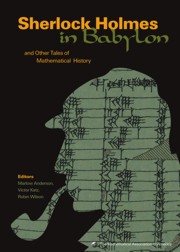Book contents
- Frontmatter
- Introduction
- Contents
- Ancient Mathematics
- Medieval and Renaissance Mathematics
- The Seventeenth Century
- Foreword
- An Application of Geography to Mathematics: History of the Integral of the Secant
- Some Historical Notes on the Cycloid
- Descartes and Problem-Solving
- René Descartes' Curve-Drawing Devices: Experiments in the Relations Between Mechanical Motion and Symbolic Language
- Certain Mathematical Achievements of James Gregory
- The Changing Concept of Change: The Derivative from Fermat to Weierstrass
- The Crooked Made Straight: Roberval and Newton on Tangents
- On the Discovery of the Logarithmic Series and Its Development in England up to Cotes
- Isaac Newton: Man, Myth, and Mathematics
- Reading the Master: Newton and the Birth of Celestial Mechanics
- Newton as an Originator of Polar Coordinates
- Newton's Method for Resolving Affected Equations
- A Contribution of Leibniz to the History of Complex Numbers
- Functions of a Curve: Leibniz's Original Notion of Functions and Its Meaning for the Parabola
- Afterword
- The Eighteenth Century
- Index
- About the Editors
Isaac Newton: Man, Myth, and Mathematics
from The Seventeenth Century
- Frontmatter
- Introduction
- Contents
- Ancient Mathematics
- Medieval and Renaissance Mathematics
- The Seventeenth Century
- Foreword
- An Application of Geography to Mathematics: History of the Integral of the Secant
- Some Historical Notes on the Cycloid
- Descartes and Problem-Solving
- René Descartes' Curve-Drawing Devices: Experiments in the Relations Between Mechanical Motion and Symbolic Language
- Certain Mathematical Achievements of James Gregory
- The Changing Concept of Change: The Derivative from Fermat to Weierstrass
- The Crooked Made Straight: Roberval and Newton on Tangents
- On the Discovery of the Logarithmic Series and Its Development in England up to Cotes
- Isaac Newton: Man, Myth, and Mathematics
- Reading the Master: Newton and the Birth of Celestial Mechanics
- Newton as an Originator of Polar Coordinates
- Newton's Method for Resolving Affected Equations
- A Contribution of Leibniz to the History of Complex Numbers
- Functions of a Curve: Leibniz's Original Notion of Functions and Its Meaning for the Parabola
- Afterword
- The Eighteenth Century
- Index
- About the Editors
Summary
Three hundred years ago, in 1687, the most famous scientific work of all time, the Philosophiae Naturalis Principia Mathematica of Isaac Newton, was published. Fifty years earlier, in 1637, a work which had considerable influence on Newton, the Discours de la Méthode, with its famous appendix, La Géométrie, was published by René Descartes. It is fitting that we celebrate these anniversaries by sketching the lives and outlining the works of Newton and Descartes.
In the past several decades, historians of science have arranged the chaotic bulk of Newton manuscripts into a coherent whole and presented it to us in numerous high quality books and papers. Foremost among these historians is Derek T. Whiteside, of Cambridge, whose eight magnificent volumes overflowing with erudite commentary have brought Newton to life again.
By unanimous agreement, the Mathematical Papers [of Isaac Newton] is the premier edition of scientific papers. It establishes a new criterion of excellence. Every further edition of scientific papers must now measure itself by its standard. [26 p. 87]
Other purposes of this article are to dispel some myths about Newton—for much of what we previously “knew” about him is myth—and to encourage the reader to look inside these volumes and to read Newton's own words, for that is the only way to appreciate the majesty of his intellect.
Newton's education and public life
Isaac Newton was born prematurely on Christmas Day 1642 (O.S.), the “same” year Galileo (1564 – 1642) died, in the family manor house at Woolsthorpe, some 90 km NNW of Cambridge.
- Type
- Chapter
- Information
- Sherlock Holmes in BabylonAnd Other Tales of Mathematical History, pp. 240 - 260Publisher: Mathematical Association of AmericaPrint publication year: 2003



